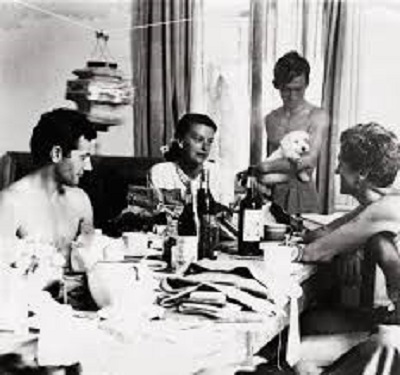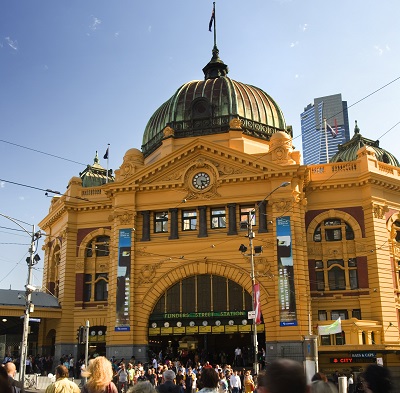NED KELLY – OUTLAW, 1955
SIDNEY NOLAN
oil and enamel paint on composition board
91.0 x 71.0 cm
signed with initial lower right: N –
signed, dated and inscribed with title verso: 20 / 1 / 55 / Nolan / NED KELLY / OUTLAW /
inscribed verso: N.F.S. / To Kym Bonython
Kym Bonython, Adelaide, by November 1960, until at least 1967
Peggy Cass, New York
Doyle’s, New York, 18 November 1999, lot 118
Gould collection, Melbourne
possibly: Sidney Nolan, The Redfern Gallery, London, 3 – 28 May 1955, cat. 7 (as ‘Portrait of a Bushranger’)
Loan Exhibition of Australian Paintings, National Art Gallery, Kuala Lumpur, November 1960, cat. 10 (illus. in exhibition catalogue)
Exhibition of Australian Painting, Malaya, Ceylon, India, cat. 12 (label attached verso)
Sidney Nolan: Retrospective Exhibition: Paintings from 1937 to 1967, Art Gallery of New South Wales, Sydney, 13 September – 29 October 1967, National Gallery of Victoria, Melbourne, 22 November – 17 December 1967, Western Australian Art Gallery, Perth, 9 January – 4 February 1968, cat. 80 (as ‘Portrait of an Outlaw’)
Sidney Nolan: Landscapes and Legends, Gould Galleries, Melbourne, 7 March – 8 April 2001, and Gould Galleries, Sydney 2 May – 3 June 2001, cat. 15 (illus. in exhibition catalogue and front cover)
Unmasked: Sidney Nolan and Ned Kelly 1950 – 1990, Heide Museum of Modern Art, Melbourne, 11 November 2006 – 4 March 2007, cat. 10
Harris, M., ‘Portrait of an Australian art collector’, Hemisphere, Sydney, July 1966, p. 21 (illus. as ‘Portrait of an Outlaw’)
Unmasked: Sidney Nolan and Ned Kelly 1950 – 1990, exhibition catalogue, Heide Museum of Modern Art, Melbourne, 2006, p. 16 (illus.)
18. Christmas at Heide, 1946.jpg

Sidney Nolan was fascinated by the story of Ned Kelly, the infamous nineteenth-century bushranger, and over the course of his career that spanned six decades it was a major theme to which he returned repeatedly. Nolan’s depiction of Kelly’s armoured mask as a black square, typically seen against a vivid blue sky, is immediately recognisable even by those who don’t know the artist’s name. Indeed, this representation has become so iconic that, in the words of one commentator, ‘Ned Kelly has … become Sidney Nolan’s image of him.’1
As a child Nolan heard stories from his grandfather who was a policeman in north-eastern Victoria and involved in tracking Kelly and his gang. Nolan was also familiar with the landscape of ‘Kelly Country’ from visiting relatives who lived in the area and having grown up in Melbourne, he had no doubt seen an example of the startling hand-forged armour fashioned from pieces of farm machinery which was on public display. The first studies depicting Ned Kelly date to early 1945 and later that year Nolan and Max Harris, a poet and co-editor of the Angry Penguins journal, travelled together to the site of the Kelly Gang’s last stand at Glenrowan, as well as to other key places in the story. This trip was part of Nolan’s research – a characteristic aspect of his working process when embarking on a new series – in which he immersed himself in the history, reading everything he could on the subject and even sought out Kelly’s younger surviving brother.
The resulting first Kelly series was famously painted on the dining table at Heide2, the home of John and Sunday Reed, between March 1946 and July 1947. Nolan had met the Reeds in 1938 and in them found informed supporters of modern art who would encourage and actively sustain his practice. In Nolan the Reeds found a young protégé, believing strongly in the quality and potential of his work. Deep emotional connections developed and by the early 1940s Nolan was engaged in an intimate and thoroughly modern relationship with the married couple.3
The series was exhibited in 1948 at the Velasquez Gallery, Melbourne, and although Nolan had left Melbourne following the breakdown of his relationship with the Reeds, John organised the exhibition on his behalf. Reed also contributed a statement to the catalogue outlining his firm belief in the significance of Nolan’s work, which he wrote was ‘of quite outstanding importance … its value in the history of Australian painting … already assured.’4 He continued, ‘we have waited many years for a mature statement to cover both the landscape and man in relation to the landscape [and] in my opinion this has now been achieved … and it is a remarkable achievement indeed, necessitating as it has the most sensitive and profound harmony between symbol, legend and visual impact. That this has been accomplished in language of the utmost simplicity is in itself an indication of the strength of the artist’s vision and discipline.’5
061159_20006.jpg

Despite John Reed’s emphatic enthusiasm for the first Kelly series – which was as it turned out prophetic – it received virtually no positive public recognition at the time. The fact that its creation was so closely intertwined with his relationship with the Reeds, and that this ended abruptly soon after it was painted, never to be revisited, might have prompted Nolan to leave the subject behind. In the mid-1950s however, by which time he had remarried and moved to England with his new family, Nolan returned to the theme in a powerful series of paintings that showed him, ten years on, to be a mature and accomplished artist. While there are strong pictorial links to the first Kelly paintings, Nolan’s reprise of the subject represents an extension of the ideas contained in the earlier series and innovations in his expression of them. The story-telling and sometimes comic detail of the 1940s pictures is replaced by what Patrick McCaughey has described as ‘tragic grandeur’. The figure of Ned Kelly looms large in these paintings, still heroic but also more human. While the iconic armoured mask remains a consistent feature, it is sometimes fragmented and opened up to reveal the bushranger’s strained face. Exposed in this way, Kelly is presented in all his humanity, just a man, flesh and blood. Nolan said that he used Kelly as a symbol of his own emotional state and in this context the comments of his friend and artist Elwyn Lynn are pertinent. ‘The Kelly saga as told in the paintings has oblique references to Nolan’s own life at the time. As his life changed he painted different Kellys: from being heroic, unassailable and defiant, Kelly became dejected, forlorn and rather frightening in later paintings.’6
Paintings from the second Kelly series were exhibited at London’s Redfern Gallery in May 1955 and the critics unanimously praised their originality and inventiveness. The Museum of Modern Art, New York purchased After Glenrowan, Siege 1955 from the Redfern exhibition and two years later, Glenrowan, 1956-57 was acquired by the Tate, London, from Nolan’s first large-scale survey exhibition at the Whitechapel Gallery. Organised by the Arts Council of Great Britain this exhibition subsequently toured the country attracting huge crowds and in conjunction with the Tate acquisition, consolidated Nolan’s reputation in England as well as adding to his increasing international reputation.7
Paintings from the second series are represented in numerous important public and private collections in Australia including: Kelly Crossing the Bridge, 1955 (National Gallery of Australia, Canberra), Ned Kelly, 1955 and Kelly, 1956 (Art Gallery of New South Wales, Sydney), Kelly with Horse, 1955 (National Gallery of Victoria, Melbourne) and After Glenrowan Siege no. 2, 1956 (TarraWarra Museum of Art Collection, Victoria).
Ned Kelly – Outlaw, 1955 was probably included in the Redfern exhibition under the title Portrait of a Bushranger. Centrally placed in the foreground of the picture, the defiant bushranger dominates the composition and while his black mask rises like an ominous sentinel, the strange bulbous eyes are cast down in an attitude of self-reflection. Strangely Nolan has depicted the rifle – a surreal extension of Kelly’s arm – with both the sight and trigger on the same side, something that would have rendered it impossible to use. Possibly nothing more than artistic licence, this detail might also reflect Nolan’s identification with the heroic outsider and his tendency to romanticise the story. The primary focus of the painting however is Kelly in the landscape. Nolan has lined up the figure’s shoulders with the horizon and the torso is painted in the same muted colours and soft brushstrokes as the flat and featureless country beyond so that Kelly becomes the landscape. As an image of a man at ease in his environment, this is a concise depiction of Kelly and also perhaps of Nolan at the time.
Ned Kelly was one of the most enduring subjects within Nolan’s oeuvre and continued to feature in his work, most notably in the monumental polyptychs, Riverbend I, 1964-65 (Australian National University, Canberra) and Riverbend II, 1965-66 (The News Corporation Collection) where he is dwarfed by the densely treed landscape that threatens to engulf him. Speaking to Elwyn Lynn about the significance of the Kelly theme within his work, Nolan imagined that it would continue until the end of his life, stating ‘I paint Kelly as part of Australia’s culture and mine … I’d like to think that the day before I died I’d paint a good Ned Kelly painting.’8
1. Rosenthal, T. G. Sidney Nolan, Thames and Hudson, London, 2002, p. 59
2. Of the 27 paintings that comprise the first Kelly series, the exception to this is First-class Marksman, 1946 (Art Gallery of New South Wales) that was painted at Stonygrad, the Warrandyte home of Danila Vassilieff. See Pearce, B., ‘Nolan’s Parallel Universe’ in Pearce, B. (ed.), Sidney Nolan, exhibition catalogue, Art Gallery of New South Wales, Sydney, 2008, p. 35 Sunday Reed gifted the paintings made at Heide to the Australian National Gallery in 1977 and they are now on permanent display at the National Gallery of Australia, Canberra.
3. See Harding, L. and Morgan, K., Modern Love: The Lives of John & Sunday Reed, The Miegunyah Press, Carlton, 2015
4. Reed, J., ‘Statement’, The “Kelly” Paintings of Sidney Nolan 1946-47, exhibition catalogue, Velasquez Gallery, Melbourne, 1948 reproduced in Reeder, W. (ed.), The Ned Kelly Paintings: Nolan at Heide 1946-47, exhibition catalogue, Museum of Modern Art at Heide, Melbourne, 1997, p. 16
5. Ibid.
6. Elwyn Lynn quoted in Rosenthal, T.G., op. cit., p. 98
7. ‘Biographical Notes’ in Pearce, B., op. cit., p. 245
8. Lynn, E. and Semler, B., Sidney Nolan’s Ned Kelly, Australian National Gallery, Canberra, 1985, p. 11
KIRSTY GRANT
FORMER DIRECTOR OF HEIDE MUSEUM OF MODERN ART,
FORMER SENIOR CURATOR, NATIONAL GALLERY OF VICTORIA
